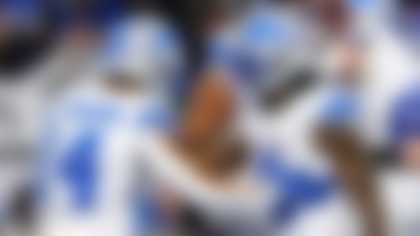Gil Brandt has watched the Pro Football Hall of Fame grow with the game since it opened in 1963 -- and he had an up-close-and-personal view in his capacity as a key member of the Dallas Cowboys' front office. In honor of the Hall of Fame's 50th anniversary, Gil offers 50 thoughts and memories about the Hall that he's accumulated over the decades as a football lifer.
STANDOUT HALL OF FAMERS
1) The Hall of Fame is full of guys with great backgrounds, but one of my favorite personal stories belongs to Rayfield Wright (Class of 2006), who was, of course, a key cog on the Dallas Cowboys when I was with the team. At his enshrinement, he told the story of how he was ready to quit football before his Fort Valley State coach kind of turned him around, getting him to play safety and tight end -- and then he ended up getting into the hall as an offensive lineman. Fittingly, he had his college coach introduce him at the Hall.
2) One of the first players I saw who I knew was going to get into the Hall someday was Forrest Gregg, the longtime Green Bay Packers offensive lineman who spent a season with the Cowboys at the end of his career. I saw him at SMU and then as a rookie. He probably played the offensive tackle position as well as anyone, period -- as good as Johnny Unitas was at quarterback. Obviously, offensive tackles don't get the attention quarterbacks get, but I thought Gregg was probably the best.
3) If I had to pick the best class, I'd have to say it was the first class, from 1963, just because of all the people in it: guys like Sammy Baugh, George Halas, Don Hutson, Curly Lambeau, John (Blood) McNally, Bronko Nagurski and Jim Thorpe.
4) I also liked the Class of 1994, because it included two Cowboys, Tony Dorsett and Randy White, plus a third guy, Jackie Smith, who ended his career in Dallas. I liked that class a lot.
5) The Class of 2000 had really good players: Howie Long, Ronnie Lott, Joe Montana and Dave Wilcox, plus Dan Rooney. Wilcox was one of those guys who fought for success the hard way after starting out at Boise Junior College.
6) Roger Staubach is one of the Hall of Famers who wowed me the most on the field, though of course he had plenty of chances to do so, given how much time I spent watching him. I also thought Deacon Jones and Ray Nitschke were special.
7) When it comes to the guys we can see on old film, one of the most impressive Hall of Famers is Arnie Weinmeister, who played defensive tackle for the New York and Brooklyn Yankees football teams in the 1940s before joining the New York Giants in the '50s. He was just the toughest guy.
8) The best quarterback in the Hall is Roger Staubach. First of all, he came back to the game after being in the armed forces for five years, which is something, because historically, guys never came back from breaks like that without losing a step or two. Staubach was the catalyst for the Cowboys; he was a great leader, both on and off the field -- even the guys on the other teams respected him greatly.
9) One of the best non-quarterbacks in the Hall has to be Eric Dickerson. He was a dominant guy; he was Adrian Peterson during a time when it was much harder to be Adrian Peterson, because we didn't have things like motion or do things like split people out.
10) Also, of course, there was Jim Brown. What Jim Brown did was unbelievable, especially when you consider that offensive linemen had to block with their shoulders at the time.
11) Other standouts:Merlin Olsen, a 14-time Pro Bowler who was simply a dominant factor for his team, and Bob Lilly, who was light years ahead of his time. Lilly was bigger, faster and quicker than anybody you'll ever see.
12) The most impactful coach/contributor in the Hall is George Halas. He helped form the league and run the league, and he dictated policy. Plus, he was a great coach for the Chicago Bears.
13) Ray Nitschke was one of the more influential players in the Hall in terms of being the leader at the luncheon on enshrinement weekend. I think it was his idea to have the luncheon on Friday. Deacon Jones took over that role from Nitschke. It will be interesting to see who takes up the mantle this year, now that Jones is gone.
14) Of course, I like to think that I have about 85 good friends in the Hall (because I think I know just about every guy in there), but one of my best friends is probably Green Bay Packers fullback Jim Taylor. I've known him a long time. You know, when you've competed against somebody and he's beaten you twice for the right to go to the Super Bowl, he tends to stick out in your mind.
EARLY HALL MEMORIES
15) Prior to the Hall of Fame coming into existence in 1963, the people who were planning it came to the league meeting in the spring to tell everyone what they wanted to do. It was exciting, because baseball and basketball each had their own hall, but we didn't. These guys were visionaries, but they weren't the kinds of visionaries who never get their plans off the ground; they actually made this thing happen.
16) Ownership then was so different from how it is now. I don't think anybody said, you know, "What do we get out of it?" The thinking is different today.
17) The early enshrinement ceremonies were really something. We used to have to sit on folding chairs on the grass out there in front of the original Hall of Fame building, where they'd set up a stage, and the 18-wheelers driving past on Interstate 77 would be blowing their horns.
18) I remember it would be about 100 degrees. The players who were already in the Hall would come back for the ceremony, and they'd be sitting up there on the stage in their gold coats, mopping their brows; it was like sitting in a sauna fully clothed.
19) In those days, we didn't exchange film like teams do now. Instead, you would go to see a handful of preseason games every year, just to see how guys on other teams were doing. (Sometimes, you'd take note of someone who could eventually be worth picking up off waivers.) That's how I found myself making my first visit to Canton; I went to scout the Hall of Fame Game between the Detroit Lions and Washington Redskins in 1965.
20) That first class I saw was quite a class; it included guys like Otto Graham, Sid Luckman, Dan Fortmann, Bob Waterfield and Steve Van Buren.
21) Then I came back in 1967. One of the enshrinees that year, former Los Angeles Rams owner Dan Reeves, was one of Tex Schramm's very good friends and someone I knew quite well. That was another good class, one that included guys like Paul Brown, Bobby Layne and Joe Stydahar, who was an amazing guy.
22) Joe Stydahar, by the way, was the first future Hall of Famer to be drafted, going to the Chicago Bears with the sixth overall pick in 1936. He's also in the West Virginia University Hall of Fame, having excelled in both basketball and football at the school.
23) The Cowboys played the Hall of Fame Game in 1968. I remember the dressing room at Fawcett Stadium being very small. It was so small, in fact, that we had to take turns dressing: first offense, then defense. At halftime, the defense met outside of the dressing room.
24) In those days, players would get their first paycheck of the year during the preseason, when the games started.For the Hall of Fame Game, I remember the Cowboys received shares for just 75 players -- at $50 apiece -- even though we came with about 100 guys. Tex Schramm was upset about that; I remember him calling and asking, to no avail, for 100-some shares.
25) That shows how different things used to be. Now, the NFL makes millions of dollars; back then, we were all fighting for scraps.
SPIRIT OF THE WEEKEND
26) Football in Canton, Ohio is kind of a way of life. Times have been tough there, and the Hall of Fame and all of the fanfare of enshrinement weekend is one of the things locals get to hang their hat on.
27) They have this party, which people from Canton can attend, on Friday night of enshrinement weekend. All of the enshrinees are introduced, and it's really something. You should see the finery; the men and women all dress up for this five-hour long cocktail dinner. It's moving and touching to see Cantonites pay their respects to the Hall.
28) They also have a parade on Saturday that winds around the Canton city streets, and thousands of people turn out to watch. They get all these old cars, '46 Chevys and so forth, and you see people of all ages in attendance. It's really a community event.
29) One of the most unbelievable Hall of Fame parties was Dan Marino's (Class of 2005). Canton isn't that far from Pittsburgh, where Marino grew up, and his party was, well, big; everybody and their brother was at Dan Marino's party. In fact, it was so big they had to go to Akron to find a venue that could host it.
30) Other parties I remember: Troy Aikman (2006) and Barry Sanders (2004) had good ones. Last year, Jack Butler had about 350 or 400 people attend his party, including Green Bay Packers coach Mike McCarthy.
31) Of course, the thing is that everyone wants to say they were invited to each enshrinee's party; it's like a badge of honor to go to those things.
32) In the 1960s, the parties weren't nearly that big; for example, I don't know if there were even 50 people at a party thrown by Tom Landry.
33) By the way, Coach Landry refused to miss the Friday practice before presenting Roger Staubach in 1985, so we practiced Friday and then took a private jet to Canton, landing at 6 a.m.
34) Another thing that's changed: Originally, the presenter for each enshrinee would present in person. But after a few went on a bit too long, the move was made to pre-tape the introductions, limiting them to about seven minutes on tape. Then the presenter gets to hand the enshrinee their bust.
WHAT THE HALL MEANS
35) I think the Hall of Fame definitely helped legitimize pro football. It helped create a history.
36) When the Hall was first built, pro football was kind of like the stepsister to college football. And then, all of a sudden, things started to change. Television came into play, and we had a lot more games on TV than college football, which had rules in place that limited exposure.
37) You go through the Hall and you see all these things that you would never think you would get to see: old programs, old sideline passes, old pictures and uniforms, old kicking shoes. One of the best things about it is that you can't ever see it all; there's always something new to take in. There's always a reason to go back.
38) I've probably been back to the Hall about 45 times. Every time I go back -- and I go about twice per year -- I see more and more things. The place is just unbelievable.
WAITING THEIR TURN
39) I don't know if there's a right way or a fair way to select new members, because we've got so many great players and owners and contributors to pick from. This year, I think there were 127 people up for consideration on the initial list, and probably three quarters of them deserve to be in the Hall. Last year, Dick Stanfel didn't get in, and he was a heck of a football player.
40) One thing nobody talks about are the blocs of voters. The West Coast bloc was probably what kept Bill Parcells out last year.
41) I've mentioned this before, but I'd like to see a separate ballot for non-player contributors. I think there have been plenty of assistant coaches and trainers over the years who deserve recognition by the Hall -- like Ralph Berlin, who was a trainer for the Steelers for many years -- but it'll be hard for them to get in when they're going up against former players.
42) One of the most talented Cowboys in the Hall, Mel Renfro, didn't get in until his final year of eligibility. He was a great defensive back, someone who came in and made the Pro Bowl as a rookie. He was also a great athlete -- if you wanted someone who could, say, run track or do the high jump, Renfro was the best we had.
43) I think that shows how the people who know the players see them in a different light than the selection committee does. When someone I knew to be worthy failed to make the cut, I used to call former Hall director Pete Elliott and say, "This isn't working; this guy's the best."
44) When I think about players who aren't in the Hall but should be, six names come to mind: Drew Pearson, Cornell Green, Cliff Harris, Lee Roy Jordan, Chuck Howley and Harvey Martin.
ODDS AND ENDS
45) From 1972 to 1990, the Senior Nominee was known as the old-timer candidate.
46) In 1990, Bob St. Clair complained about the moniker, and it was changed that year -- when St. Clair entered the Hall.
47) There are only two draft classes (from 1936 to 1990) with no representatives in the Hall of Fame: the Class of 1943 and the Class of 1986. There's a very long shot someone from '86 could still make it, but there's probably no hope for '43.
48) Cal Hubbard is currently the only person in both the Pro Football Hall of Fame (as a player) and the Baseball Hall of Fame (as an umpire).
49) There are no punters in the Hall, though there are three members who are credited as placekickers: George Blanda, Lou Groza and Jan Stenerud.
50) The Hall was originally slated for Latrobe, Pa., but the town couldn't raise the necessary funds to build it.
Follow Gil Brandt on Twitter _@GilBrandt_.




